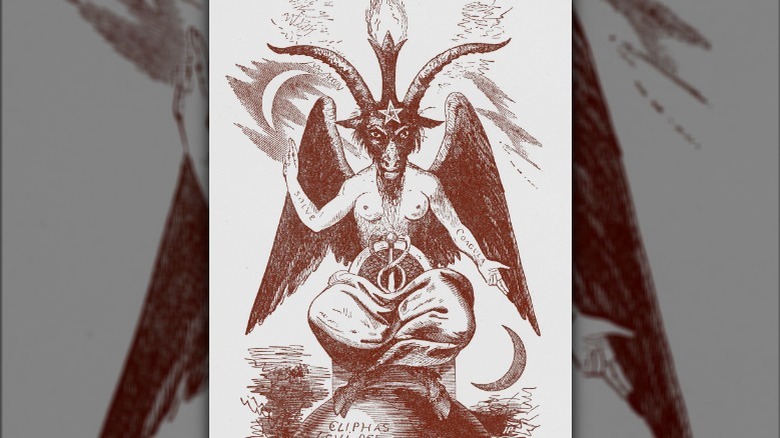Snoop Dogg Debunks Claims Over Satanic Necklace At The Olympics But Some Fans Don't Buy It
Satanic imagery and the inevitable uproar that follows (Satanic Panic anyone?) appear to be making a comeback. From Lil Nas X to Sam Smith, "demonic" symbolism seems to be cropping up lately. Or as Complex says, people are just looking for it more — "people who somehow view everything as a direct threat to their personal religious beliefs while simultaneously failing to correctly identify the very imagery they claim to hold so dear."
As of this writing, Snoop Dogg is the current artist facing scrutiny for such imagery thanks to a necklace he wore at the 2024 Summer Olympics in Paris, France that people are calling — you guessed it — "satanic." Specifically, they linked it to Baphomet, a horned creature with the body of a human and head and legs of a goat that has become associated with the occult over the years. The "Gin and Juice" rapper brushed off the claims and quite frankly told people to "leave [him] the f*** alone."
"I don't know what y'all thought this was but this is the goat," Snoop said in an Instagram story on Monday. "I had this made because somebody told me I was the goat so I wanted to make me a goat chain. All that other s*** y'all talking about, I don't know what y'all talking about. But this is the GOAT, greatest of all time, with a blue diamond on his head. Gold. A goat. That other s*** y'all talking about, miss me with that b*******."
Some fans aren't convinced
A quick scan of social media reveals some doubters of the Dogg Father. "If you were on the fence about which side Snoop was on — he made it clear upon his appearance at the Satanic Olympics ritual," one user wrote on X, formerly Twitter. "He wears Baphomet upon his heart." Another X user wrote: "We all know what that is boy. ... That's the f****** devil dude ... and you're his boy now!" And on Instagram: "Common Snoop we ain't kids around here."
As for Snoop Dogg's defense, the Des Moines Register says the "GOAT" acronym likely came from the hip-hop scene in the 1990s and was vaulted into the English lexicon after the release of rapper LL Cool J's 2000 album "G.O.A.T." "I got the term from two people," he explained to Change the Game TV. The "Doin' It" lyricist pointed to Muhammad Ali — who "obviously said he was the greatest of all time" — and American street ballplayer Earl Manigault, or "the GOAT."
Who or what is Baphomet?
Nowadays, Baphomet is depicted in popular culture as a deity or demon in everything from movies and video games to pennants and artwork. But Baphomet wasn't a real god — it doesn't appear to have been truly worshiped by anyone, and all of the modern portrayals we mentioned stem from an 1854 drawing by 19th-century French occultist Eliphas Levi (above). In a piece for the journal Correspondences, religious scholar Julian Strube said the Kabbalistic author wanted to create a "symbolization of the equilibrium of opposites." Strube said Levi was likely inspired by various sources, including the Tarot card "Le Diable" from the Marseille deck and the 1608 "Compendium Maleficarum," a witch-hunter's bestiary. Flash-forward to the 20th century, and Anton LaVey, the founder of the Church of Satan and author of 1969's "Satanic Bible," took Levi's depiction and used it to make the official symbol for the organization. The word "Baphomet" itself, though, has a far older history.
It first appears in the history books in the First Crusade from 1096 to 1102 C.E. in its Latin form, "Baphometh," when crusader Anselme of Ribemont (who may or may not have understood Turkish) heard Turks calling upon "Baphomet." In the years leading up to the 4th-century Renaissance, various texts use the name to refer to Islam, and indeed some believe "Baphometh" is a corruption of "Mahomet," an alternate spelling of Muhammad, the founder and prophet of Islam.
In the 1300s, Baphomet was associated with the persecution of the Knights Templar, a religious military order that was founded to help Christian pilgrims reach Jerusalem. They were accused of all kinds of blasphemy, from homosexuality to orgies, and tortured into admitting to them. Notably, they were said to have worshiped a skull (possibly a cat's) they reportedly called "Baphomet."
Satanist or artist?
If you're inclined to believe Snoop Dogg is a Satanist and look hard enough, you can probably find enough proof to convince yourself. In 2015, the rapper partnered with a design firm called Pentagram to devise the brand identity of his cannabis-based product line Leafs by Snoop. The independent studio, of course, bears the same name as the pointed star polygon that has become linked with Satanism and associated organizations like the Church of Satan and The Satanic Temple. Elsewhere, when inducting Tupac Shakur into the Rock & Roll Hall of Fame in 2017 (above), Snoop Dogg wore what appeared to be a Gucci hoodie with cartoon pentagrams plastered across it.
So what does it all mean? Well, probably nothing. The specific polygon associated with Satanism is inverted, often in the form of a pentacle — a pentagram with a circle around it. Sometimes there's an image of Baphomet in the center, its horns corresponding to the two top tips of the pointed figure. And according to Britannica, the symbol's meaning has "varied wildly" across history, symbolizing everything from protection to perfection to the devil and humanity. In other words, whether Snoop Dogg is a Satanist probably comes down to how much you want him to be. Realistically, he's probably just a rapper who wants to be left alone.
If you're still curious, check out the disturbing details about Baphomet you never knew.


